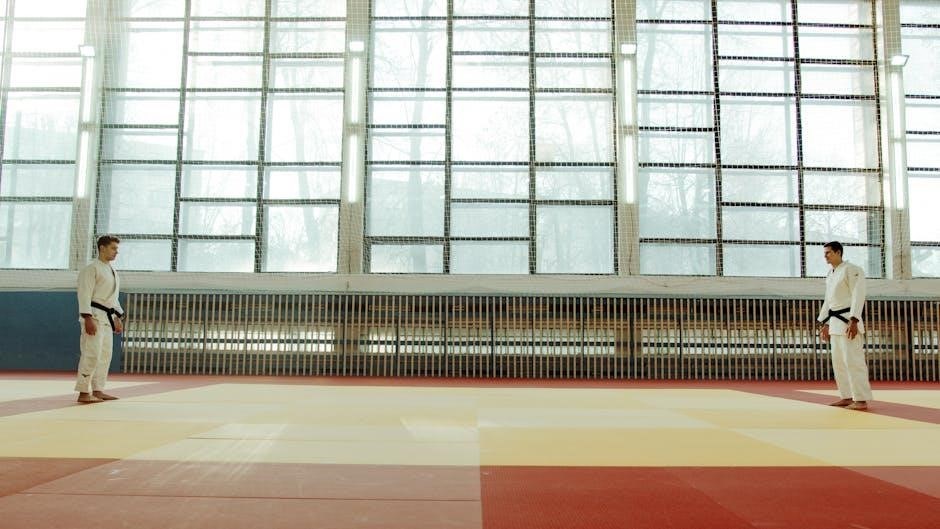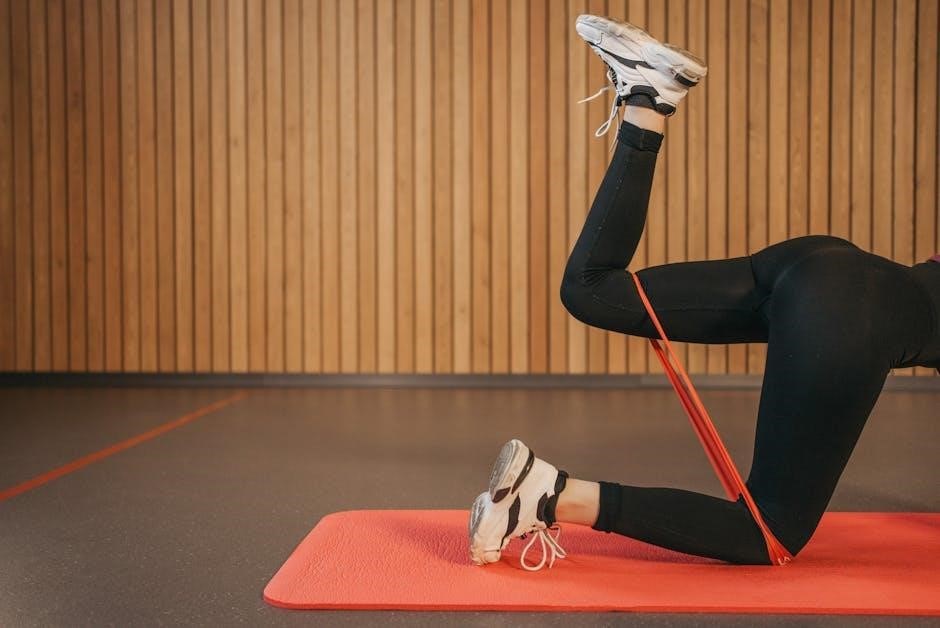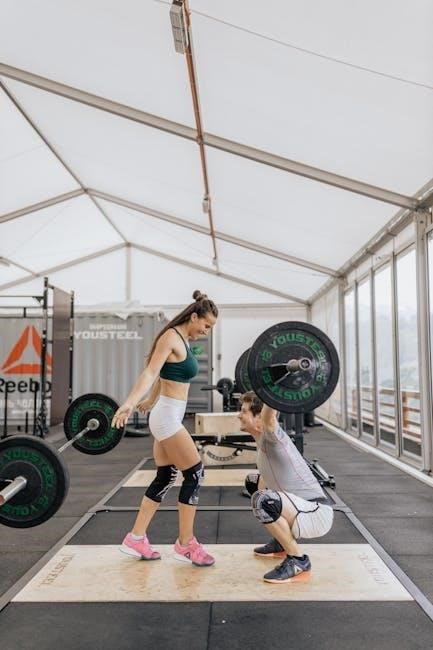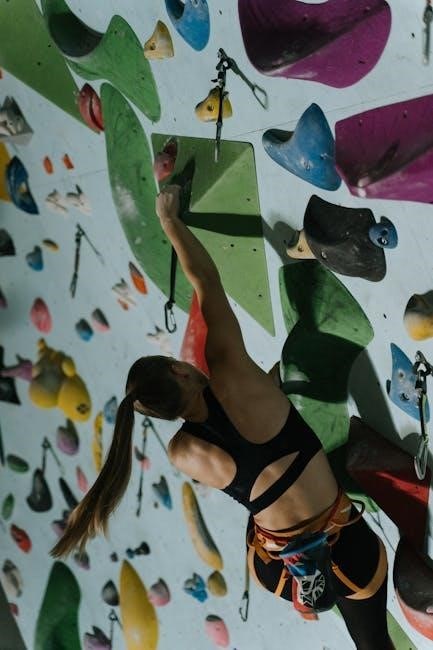Resistance training involves exercises that work muscles against an external load, enhancing strength, endurance, and power. It is a cornerstone of fitness, promoting muscle growth and overall health.
1.1. Definition and Purpose of Resistance Training
Resistance training, also known as strength training, involves performing exercises against an external load to enhance muscular strength, endurance, and power. It is designed to improve muscle hypertrophy, bone density, and overall physical performance. The primary purpose is to challenge muscles through progressive overload, using tools like free weights, resistance bands, or machines. This form of training is essential for athletes and individuals seeking to build lean muscle, boost metabolism, and enhance functional movement. By targeting specific muscle groups, resistance training helps achieve balanced physique, improves joint stability, and reduces injury risk. It is a cornerstone of fitness regimens, offering long-term health benefits and enhanced athletic performance.
1.2. Benefits of Resistance Training
Resistance training offers numerous benefits, including increased muscle strength, endurance, and power. It enhances muscle hypertrophy, boosting metabolism and aiding in weight management. This form of training improves bone density, reducing the risk of osteoporosis and fractures. Additionally, it elevates overall physical performance, making daily activities and sports easier. Resistance training also supports functional movement, improving balance and coordination. It can enhance mental health by reducing stress and anxiety, while promoting better sleep quality. Regular engagement in resistance exercises can lower the risk of chronic diseases, such as diabetes and heart disease. Furthermore, it increases joint stability, reducing the likelihood of injuries. Overall, resistance training is a versatile and effective way to achieve holistic health and fitness, benefiting individuals of all ages and fitness levels.
1.3. Key Components of a Resistance Training Program
A well-structured resistance training program includes clear exercise selection, proper technique, and progression strategies. It involves understanding the muscles targeted, the equipment or tools needed, and the appropriate intensity. A foundational component is a workout routine that balances volume, frequency, and variety to avoid plateaus. Incorporating a mix of compound and isolation exercises ensures comprehensive muscle development. Safety is paramount, with a focus on proper form to prevent injuries. Additionally, the program should include strategies for progression, such as increasing weight, reps, or changing exercises. Adequate recovery time and nutrition are also essential components to support muscle growth and overall performance. A structured plan with these elements ensures effectiveness and sustainability for long-term fitness goals.

Fundamental Principles of Resistance Training
Resistance training relies on progressive overload, specificity, and recovery. These principles ensure targeted muscle growth, improved strength, and sustained physical adaptation over time effectively.
2.1. Progressive Overload
Progressive overload is a cornerstone of resistance training, emphasizing the gradual increase in weight, resistance, or intensity to challenge muscles and promote continuous growth. This principle ensures that muscles are consistently stimulated to adapt, preventing plateaus and enhancing strength and hypertrophy. It can be achieved by increasing the load, repetitions, or reducing rest periods between sets. Proper application of progressive overload requires careful planning to avoid injury and maintain technique. Research and exercise manuals highlight its importance in achieving long-term physical improvements, making it a fundamental aspect of any effective training program.
2.2. Specificity of Training
Specificity of training refers to tailoring exercises and programs to meet individual goals, ensuring that workouts target specific muscle groups or movement patterns. This principle emphasizes that training should align with the desired outcomes, whether strength, endurance, or power. For example, a powerlifter focuses on exercises that mimic their competition lifts, while an endurance athlete incorporates higher-repetition, lower-load exercises. Proper application of specificity ensures that efforts are directed toward achieving specific physiological adaptations, enhancing the efficiency and effectiveness of the training program. It also involves selecting exercises that closely replicate the movements or demands of one’s sport or activity, making the training more relevant and impactful.
2.3. Recovery and Rest Periods
Recovery and rest periods are essential for muscle repair, growth, and adaptation after resistance training. Adequate recovery allows muscles to rebuild and strengthens connective tissues, reducing injury risk. Insufficient recovery can lead to overtraining, decreased performance, and prolonged fatigue. Key recovery strategies include adequate sleep, proper nutrition, and rest days. Active recovery, such as light cardio or stretching, can also enhance the repair process. Muscles typically require 48-72 hours of rest between intense workouts targeting the same muscle group. Incorporating rest periods between sets and exercises ensures optimal recovery during training sessions. Ignoring recovery can hinder progress and increase the likelihood of overtraining syndrome, which may require extended periods of rest to resolve.
2.4. Proper Warm-Up and Cool-Down Routines
A proper warm-up prepares the body for resistance training by increasing heart rate, improving flexibility, and reducing injury risk. It typically includes dynamic stretching, light cardio, and muscle activation exercises. Dynamic stretches, such as arm circles and leg swings, enhance mobility without causing muscle strain. Light cardio, like jogging or cycling, increases blood flow and raises core temperature. Muscle activation exercises, such as glute bridges or planks, engage key stabilizers for better form during training.
A cool-down involves static stretching and foam rolling to aid recovery. Static stretches, held for 20-30 seconds, improve flexibility and reduce muscle tension. Foam rolling promotes blood flow, relieving muscle soreness and improving mobility. Both routines should last 5-10 minutes to maximize benefits and support overall performance.

Upper Body Resistance Training Exercises
Focuses on building strength in chest, shoulders, back, and arms through compound exercises like bench presses and pull-ups, as well as isolation exercises like bicep curls.
3.1. Bench Press Technique and Variations
The bench press is a cornerstone exercise for upper body strength, targeting the chest, shoulders, and triceps. Proper technique involves lying on a flat bench, gripping the bar slightly wider than shoulder-width, and lowering the bar to the chest before pressing it back up. Setup is crucial: feet flat on the floor, shoulders pinned to the bench, and a neutral spine. Grip variations include wide, medium, and close grips, each emphasizing different muscle groups. Common variations include the incline bench press (targeting the upper chest) and the decline bench press (focusing on the lower chest). Dumbbell bench presses allow for greater range of motion and emphasize stabilizer muscles. Safety is paramount, with a spotter recommended for heavy lifts to prevent injury. Proper breathing and controlled movement ensure effectiveness and minimize risk.
3.2. Pull-Up and Lat Pulldown Exercises
Pull-ups and lat pulldowns are essential exercises for building back strength, particularly targeting the latissimus dorsi muscles. Pull-ups involve hanging from a bar and pulling oneself up until the chin clears the bar. They can be performed with an overhand, underhand, or neutral grip, each variation emphasizing different muscle groups. Lat pulldowns mimic the pull-up motion using a machine, allowing for controlled resistance. Proper technique involves sitting with knees securely under the pad, gripping the bar shoulder-width apart, and pulling it toward the chest while maintaining a stable core. Both exercises improve lat development and overall upper body strength. Variations, such as wide-grip or close-grip pulls, can further isolate specific muscles. Consistency and progression in these exercises yield significant gains in muscular endurance and hypertrophy.
3.3. Shoulder Press and Lateral Raises
The shoulder press and lateral raises are cornerstone exercises for developing shoulder strength and hypertrophy. The shoulder press involves pressing a weight overhead, targeting the deltoids, triceps, and trapezius muscles. It can be performed with dumbbells, a barbell, or a machine, each offering unique benefits. Lateral raises focus on the lateral deltoids, enhancing shoulder width and aesthetics. Proper technique includes lifting the arms to shoulder height with a slight bend in the elbows, avoiding swinging or using momentum. Both exercises improve posture, functional strength, and overall shoulder stability. Variations, such as incline or cable lateral raises, can further isolate specific muscle fibers. Consistent practice with progressive overload ensures robust shoulder development and injury prevention.
3.4. Bicep Curls and Tricep Dips
Bicep curls and tricep dips are essential exercises for arm development. Bicep curls target the biceps brachii, forearms, and brachialis, enhancing arm flexion strength. They can be performed with dumbbells, barbells, or cables, using various grips like underhand or neutral. Proper form involves keeping elbows close to the body and avoiding shoulder involvement. Tricep dips focus on the triceps, anterior deltoids, and chest muscles, improving elbow extension and stability. They can be done on a bench, rings, or a dip bar, with variations like weighted dips for added resistance. Both exercises are versatile, offering progression from basic to advanced levels. Consistent practice with proper technique ensures balanced arm development and functional strength for daily activities and sports performance.

Lower Body Resistance Training Exercises
Lower body resistance training focuses on exercises like squats, deadlifts, and lunges to build strength, power, and muscle mass in the legs and hips. Proper form is crucial.
4.1. Squat Technique and Variations
The squat is a foundational lower body exercise that targets the quadriceps, hamstrings, glutes, and core muscles. Proper technique involves standing with feet shoulder-width apart, engaging the core, and lowering the body by bending the knees and hips. The back should remain straight, and the chest upright throughout the movement. Variations include the back squat, front squat, and overhead squat, each with slight differences in barbell placement and muscle emphasis. The back squat is the most common, with the bar placed across the shoulders, while the front squat places the bar at shoulder height, engaging the upper back and core more intensely. Overhead squats require the bar to be held overhead, challenging shoulder mobility and stability. Each variation demands precise form to maximize effectiveness and prevent injury.
4.2. Deadlifts and Romanian Deadlifts
The deadlift is a compound exercise that involves lifting a barbell from the ground to hip level, engaging multiple muscle groups, including the hamstrings, glutes, back, and core. Proper technique requires maintaining a neutral spine, gripping the bar with hands shoulder-width apart, and driving through the heels; The Romanian deadlift (RDL) is a variation that starts from a standing position, focusing on the eccentric phase of the movement, with the barbell hanging below the knees. This emphasizes the hamstrings and glutes while reducing lower back stress. Both exercises are essential for building strength and muscle mass, but they require precise form to avoid injury. Variations, such as using different grips or incorporating deficit deadlifts, can further challenge lifters and target specific muscle groups.
4.3. Lunges and Step-Ups
Lunges and step-ups are versatile exercises that target the lower body, particularly the quadriceps, hamstrings, and glutes. Lunges involve stepping forward or backward, lowering the body until both knees form 90-degree angles, and then returning to the starting position. Proper form is crucial to prevent knee strain, ensuring the front knee does not extend past the toes. Step-ups require stepping onto a platform or bench, emphasizing balance and functional strength. Both exercises can be modified with added resistance, such as dumbbells or a barbell, to increase intensity. Variations like walking lunges or lateral lunges further challenge coordination and stability. Step-ups also improve proprioception and can be adapted by adjusting step height and resistance levels. Mastering proper form is essential to maximize benefits and prevent injury, aligning with the principles outlined in the Exercise Technique Manual for Resistance Training.

4.4. Leg Press and Leg Extensions
The leg press and leg extensions are effective lower body exercises that target the quadriceps, hamstrings, and glutes. The leg press involves pushing a platform away using the feet, working multiple muscle groups simultaneously. Leg extensions, on the other hand, isolate the quadriceps, focusing on knee extension. Both exercises are essential for building strength and muscle endurance. Proper form is crucial to avoid injury, emphasizing full range of motion and controlled movements. Variations, such as using different foot positions or adding resistance, can enhance the effectiveness of the leg press. Leg extensions are particularly useful for targeting the quads without putting excessive strain on other joints. Incorporating these exercises into a lower body routine can significantly improve overall leg development and functional strength. Always prioritize proper technique to maximize benefits and minimize injury risks.

Core and Functional Resistance Training
Core and functional resistance training enhances stability, strength, and endurance of the abdominals, obliques, and lower back, improving posture, balance, and overall functional movement patterns.
5.1. Planks and Stability Exercises
Planks are a cornerstone of core training, targeting the abdominals, obliques, and lower back muscles. They improve stability, posture, and overall core strength. Variations like forearm planks, side planks, and dynamic movements enhance engagement. Proper form is crucial to avoid strain and maximize benefits. Stability exercises, such as bird dogs and single-leg holds, further challenge balance and functional strength, reducing injury risk and improving athletic performance. These exercises are versatile, suitable for all fitness levels, and can be modified to increase difficulty progressively.
5.2. Russian Twists and Oblique Work
Russian twists target the oblique muscles, enhancing rotational strength and core stability. Perform by sitting with knees bent, leaning back slightly, and twisting the torso while holding a weight or medicine ball. This exercise improves posture, balance, and functional movement. Variations include using resistance bands or cables for added challenge. Proper form is essential to avoid spinal strain. Incorporate Russian twists into your routine for a stronger, more defined core. They complement planks and other stability exercises, providing a well-rounded core workout. Regular practice enhances athletic performance and reduces injury risk. Focus on controlled movements and gradually increase resistance for progressive overload. This exercise is versatile and effective for all fitness levels, making it a key component of any resistance training program.
5.3. Cable Rotations and Functional Movements
Cable rotations are dynamic exercises that target the core muscles, particularly the obliques, while improving rotational strength and stability. They involve holding a cable handle and rotating the torso, keeping the arms straight. This movement mimics real-life actions like swinging a bat or throwing, making it highly functional. Proper form is essential to avoid injury, with focus on controlled rotation and engagement of the core. Functional movements like cable rotations enhance coordination, balance, and overall athletic performance. They can be varied by adjusting resistance levels, angles, and speeds. Incorporating these exercises into a resistance training program helps improve posture, reduces injury risk, and boosts daily functionality. They complement planks and Russian twists, offering a well-rounded core workout that prioritizes both strength and mobility. Regular practice promotes long-term physical fitness and active lifestyles. Always prioritize proper form to maximize benefits and minimize risk.

Exercise Progression and Variation
Progression involves gradually increasing resistance or intensity to challenge muscles. Variation includes modifying exercises, rep ranges, or angles to keep workouts engaging and effective for continuous growth.
6.1. Increasing Weight and Resistance
Increasing weight and resistance is a fundamental aspect of resistance training, ensuring continuous muscle growth and strength gains. This is achieved through progressive overload, where the intensity of workouts is gradually heightened. One common method is to add weight or resistance in small increments over time, allowing muscles to adapt without causing injury. For example, if an individual can comfortably lift 70 pounds for 8 repetitions, they might increase the weight by 2.5-5 pounds weekly. Proper form must always be maintained to prevent injury. The rate of progression varies depending on individual strength levels and goals, but consistency is key. This approach ensures muscles remain challenged, fostering ongoing development and avoiding plateaus. Regularly assessing and adjusting the load helps tailor the training to meet specific objectives, whether strength, hypertrophy, or endurance. Safety and gradual progression are paramount to long-term success in resistance training programs.
6.2. Changing Repetition Ranges
Changing repetition ranges is a critical strategy in resistance training to target different muscle properties and avoid plateaus. Repetition ranges refer to the number of times an exercise is performed in a single set. Lower repetition ranges (1-5 reps) focus on building maximum strength, while higher ranges (12-20 reps) emphasize muscle endurance and hypertrophy. Adjusting the repetition range allows for varied training goals, such as power, strength, or muscle growth. For example, shifting from 8-12 reps to 4-6 reps increases intensity for strength gains. Incorporating a mix of repetition ranges ensures well-rounded development and keeps workouts engaging. Proper progression and variation in repetition ranges, combined with appropriate weight adjustments, enhance overall muscle adaptation and prevent stagnation in training. This flexibility makes resistance training adaptable to individual goals and fitness levels, ensuring continuous progress over time. Consistency in altering repetition ranges is essential for achieving desired outcomes.
6.3. Modifying Exercise Angles and Grips
Modifying exercise angles and grips is an effective way to target different muscle groups and enhance training variety. Changing the angle of an exercise alters the emphasis on specific muscles, preventing plateaus and improving overall development. For example, incline bench presses target the upper chest, while decline presses focus on the lower chest. Grips, such as overhand versus underhand, can also shift muscle activation, with wide grips emphasizing lat engagement and narrow grips targeting triceps. These adjustments allow for a more comprehensive workout, ensuring balanced muscle growth and functional strength. Additionally, modifying angles and grips can reduce the risk of overuse injuries by distributing stress across different areas. This versatility makes resistance training highly customizable to individual goals and anatomical needs, ensuring continuous progression and engagement in workouts. Regularly incorporating such variations keeps training dynamic and effective.

Safety and Injury Prevention
Proper lifting techniques and avoiding heavy loads without support are crucial to prevent injuries. Using weightlifting belts and wrist straps can add protection during exercises.
7.1. Proper Lifting Techniques
Proper lifting techniques are essential to minimize injury risks during resistance training. Maintaining a neutral spine and engaging core muscles help distribute weight evenly. Lifters should avoid rounding their backs, as this can lead to spinal injuries. Instead, hinge at the hips and use leg strength to lift, keeping the weight close to the body. Ensuring equipment is properly secured and warming up before lifting are also critical. When performing exercises like deadlifts or squats, focus on controlled movements and avoid jerking or bouncing weights. Using spotting partners or safety racks can add an extra layer of protection. Remember, there is no legal maximum weight for safe lifting, as any weight can potentially cause harm if not handled correctly. Always prioritize form and technique to safeguard against injuries.
7.2. Common Injuries and Prevention Strategies
Common injuries in resistance training include shoulder strains, lower back pain, and knee injuries, often caused by poor form or overexertion. Preventing these injuries requires attention to proper technique, warm-ups, and recovery; Strengthening secondary muscles, such as shoulder stabilizers and core muscles, can reduce injury risk. Incorporating stretching and mobility exercises improves flexibility and reduces muscle imbalances. Avoiding overtraining and ensuring adequate rest periods is crucial. Using safety equipment, like weightlifting belts for heavy lifts, can also protect against injury. Addressing muscle imbalances through targeted exercises helps maintain proper movement patterns. By prioritizing form, recovery, and a well-rounded training program, individuals can minimize the risk of common resistance training injuries and maintain long-term progress safely.

Accessories and Training Tools
Resistance bands, weightlifting belts, and wrist straps are essential training tools. Bands add versatility, belts support the lower back, and straps enhance grip during heavy lifts safely.
8.1. Resistance Bands and Their Applications
Resistance bands are versatile and portable tools used in strength training. They provide continuous tension, enhancing muscle engagement and improving flexibility. Available in varying resistance levels, they suit all fitness levels.
Bands are ideal for full-body workouts, targeting major muscle groups like chest, shoulders, and legs. They can also assist in rehabilitation, offering low-impact exercises for recovery. Their portability makes them perfect for travel or home use.
Resistance bands are cost-effective and space-efficient, making them a popular choice for both beginners and advanced trainees. They allow for creative exercise variations, ensuring a comprehensive and dynamic training experience. A must-have for any resistance program.
8.2. Weightlifting Belts and Wrist Straps

Weightlifting belts and wrist straps are essential accessories in resistance training, designed to enhance performance and prevent injuries. A weightlifting belt provides lumbar support during heavy lifts, stabilizing the core and reducing the risk of lower back strain. It is particularly useful in exercises like squats and deadlifts, where spinal integrity is crucial. Wrist straps, on the other hand, assist in maintaining grip on heavy weights, allowing lifters to focus on the movement pattern without losing hold of the barbell or dumbbells. Both accessories are widely used by athletes and recreational lifters to optimize their training sessions. Proper use of these tools can improve overall lifting efficiency and safety, making them valuable additions to a resistance training program.
